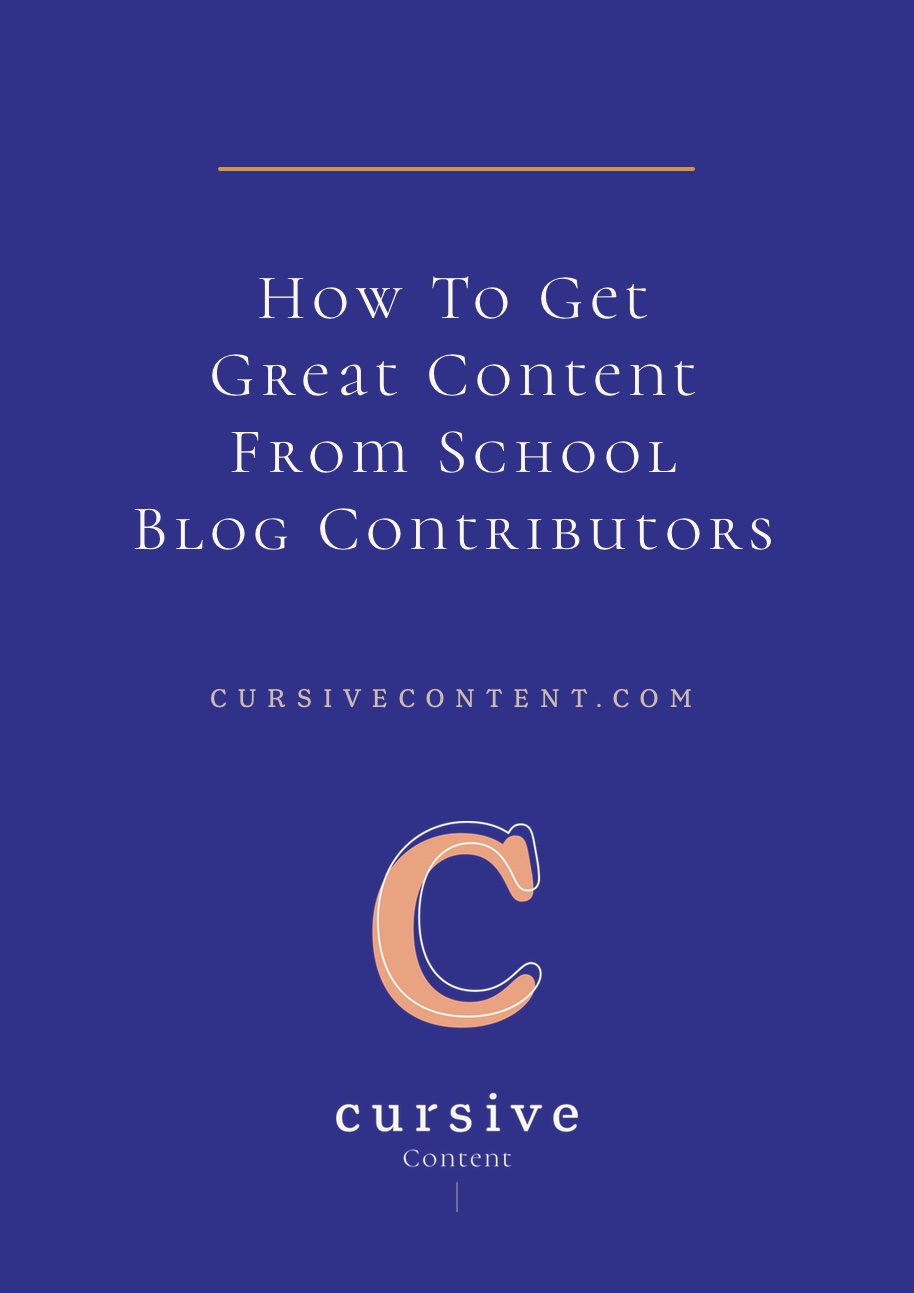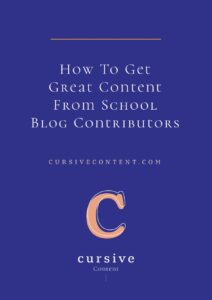How To Get Great Content From School Blog Contributors

You’re in charge of your school’s blog content, yet you’re a small (or solo!) team. So the logical way to keep your blog up-to-date and interesting? You ask for others to contribute content.
But how can you ensure that the content they contribute is strategic, engaging and aligns with your marketing goals — especially when they’re not marketers?
This is one of the most common content hurdles I hear about from my school clients: it’s so hard to get quality content from colleagues, especially when you’re basically asking them to do you a favor and take time out of their own workday to write content for your school blog.
However, with a little planning and guidance, you can make the most of their time AND get the content you need to create a quality, strategy-focused blog.
There are a few things you can do to improve the quality and timeliness of content contributions:
#1: Don’t Ask Contributors To Write.
You read that correctly. Writing can be extremely intimidating. Even if someone has a fantastic idea for a blog post, or insights into an issue that would make a truly compelling story, the act of writing those thoughts into an article is often very stressful — especially if they will be given writing credit.
Ease the pressure for your content contributors by asking for their main ideas in bulleted format, or their rough ideas in outline format, rather than asking for a completed piece. Then you can take their ideas and craft them into an article that serves your audience and your marketing strategy.
But what if you don’t have time to do all of this writing and editing yourself, you ask? Well…
#2: Ask For A Key-Points Overview.
If you really need your contributors to do the heavy writing for you because you simply don’t have the time or capacity to write the posts yourself, have contributors accompany each submission with a key-points overview. This overview will help both them and you focus on the article’s most important themes, so that if you do need to copyedit it for clarity and direction, you know where to start.
The key-points overview should include a few basic areas of information:
- Who is the audience for this article? By making your contributor define the audience, you will help them focus their ideas. If you have already done the work and defined one or more key audiences for your blog (woohoo!), this could be a multiple-choice question.
- How will this article provide value to this audience? You want to make sure every post is serving your audience and helping them in some way.
- What are the top 2 takeaways for this article? Your blog posts should be easy to scan and understand. By knowing the intended takeaways, you can make sure the key points appear as subheads or bullets within the article.
- What should the audience do after reading this article? There has to be a call-to-action, a next step, in order for your blog to work harder for your school. Get your contributors thinking about this up front.
#3: Make It Fun!
If your contributors feel like writing for the school blog is a burden, that negative energy will seep into their content. Make sure you thank them for their involvement and make contributing fun.
We share a variety of ideas on how to do this in the post The Big List of Ways to Get Employees Involved in Content Marketing, but here are a few of our favorites:
- Create an editorial board. Include professionals from various departments, and meet regularly to brainstorm stories and ideas. You can even feature your editorial board on your blog or website to give members heightened exposure and credit for their work.
- Create story prompts. Often, people don’t recognize the stories they have because these stories are so woven into their daily jobs. Every once in a while, send your contributors an offbeat or unusual question. Questions like, “When was the last time you bragged to your family about doing a good job?” and “What happened the last time a student/parent complimented you?” will help them think about their jobs in a new way.
- Ask for frequently asked questions. Have contributors submit the questions they are asked most often by students/families, and use these questions for content creation ideas.
- Find out what they read. People from various departments will have various professional interests. Find out what publications they read to expand your content curation efforts.
- Keep them informed. Create an internal eNewsletter that shares your latest content, provides updates on your efforts, and highlights (and thanks!) contributors. This will help spread goodwill. A little gratitude goes a long way.
Being intentional and strategic with your content requests will keep contributors interested and engaged — resulting in stronger stories for your school blog.
Code for hiding image:
MORE ARTICLES
-
 AI Writing Prompts to Power Private School Storytelling
AI Writing Prompts to Power Private School Storytelling -
 How to Write a Compelling School Magazine Article People Want to Read
How to Write a Compelling School Magazine Article People Want to Read -
 How to Get School Blog Readers to Stick Around
How to Get School Blog Readers to Stick Around -
 Craft a Better School Blog Post with These 5 Quick Edits
Craft a Better School Blog Post with These 5 Quick Edits -
 Quick Fixes to Make Your School Blog Post Instantly Pop
Quick Fixes to Make Your School Blog Post Instantly Pop -
 10 Do’s and Don’ts for School Blogs
10 Do’s and Don’ts for School Blogs -
 The Case for School Content Marketing
The Case for School Content Marketing -
 5 Quick Tips for Crafting a Standout School Blog Post
5 Quick Tips for Crafting a Standout School Blog Post

